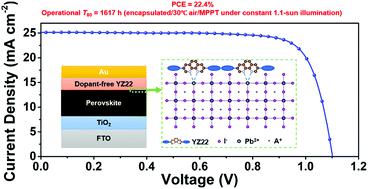当前位置:
X-MOL 学术
›
Energy Environ. Sci.
›
论文详情
Our official English website, www.x-mol.net, welcomes your feedback! (Note: you will need to create a separate account there.)
A hole-transport material that also passivates perovskite surface defects for solar cells with improved efficiency and stability
Energy & Environmental Science ( IF 32.5 ) Pub Date : 2020-09-23 , DOI: 10.1039/d0ee01655a By Xiaoming Zhao 1, 2, 3, 4 , Chao Yao 1, 2, 3, 4 , Kaichen Gu 1, 2, 3, 4 , Tianran Liu 1, 2, 3, 4 , Yu Xia 1, 2, 3, 4 , Yueh-Lin Loo 1, 2, 3, 4, 5
Energy & Environmental Science ( IF 32.5 ) Pub Date : 2020-09-23 , DOI: 10.1039/d0ee01655a By Xiaoming Zhao 1, 2, 3, 4 , Chao Yao 1, 2, 3, 4 , Kaichen Gu 1, 2, 3, 4 , Tianran Liu 1, 2, 3, 4 , Yu Xia 1, 2, 3, 4 , Yueh-Lin Loo 1, 2, 3, 4, 5
Affiliation

|
While typical perovskite solar cells (PSCs) with doped Spiro-OMeTAD as a hole transport material (HTM) have shown rapid increase in their power-conversion efficiencies (PCEs), their poor stability remains a big concern as the dopants and additives used with Spiro-OMeTAD have a strong tendency to diffuse into and degrade the perovskite active layer under normal operating conditions. Aiming to push forward the development of PSCs, many dopant-free small-molecular HTMs have been reported based on energetic considerations for charge transfer and criteria for charge transport. However, the PCEs of the state-of-the-art PSCs with dopant-free small-molecular HTMs are still inferior to those using doped Spiro-OMeTAD, and little attention has been paid to the interactions between the HTM and perovskite absorber in PSCs. Here, we report a facile design concept to functionalize HTMs so that they can passivate perovskite surface defects and enable perovskite active layers with lower density of surface trap states and more efficient charge transfer to the hole transport layer. As a consequence, perovskite solar cells with a functionalized HTM exhibit a champion PCE of 22.4%, the highest value for PSCs using dopant-free small molecular HTMs to date, and substantively improved operational stability under continuous illumination. With a T80 of (1617 ± 7) h for encapsulated cells tested at 30 °C in air, the PSCs containing the functionalized HTM are among the most stable PSCs using dopant-free small-molecular HTMs. The effectiveness of our strategy is demonstrated in PSCs comprising both a state-of-the-art MA-free perovskite and MAPbI, a system having more surface defects, and implies the potential generality of our strategy for a broad class of perovskite systems, to further advance highly efficient and stable solar cells.
中文翻译:

一种空穴传输材料,还可以钝化钙钛矿表面缺陷的太阳能电池,从而提高了效率和稳定性
虽然典型的以掺杂Spiro-OMeTAD作为空穴传输材料(HTM)的钙钛矿太阳能电池(PSC)已显示出其功率转换效率(PCE)迅速增加,但其不良的稳定性仍是备受关注的问题,因为与Spiro一起使用的掺杂剂和添加剂在正常操作条件下,-OMeTAD具有很强的扩散和降解钙钛矿活性层的趋势。为了推动PSC的发展,基于电荷转移的积极考虑和电荷转移的标准,已经报道了许多无掺杂的小分子HTM。但是,具有无掺杂小分子HTM的最新PSC的PCE仍然不如使用掺杂Spiro-OMeTAD的PCE,并且在PSC中HTM与钙钛矿吸收剂之间的相互作用几乎没有引起注意。 。这里,我们报道了一种简便的设计概念,可以对HTM进行功能化,以便它们可以钝化钙钛矿表面缺陷,并使钙钛矿活性层具有较低的表面陷阱态密度和更有效的电荷转移至空穴传输层。结果,具有功能化HTM的钙钛矿太阳能电池的PCE冠军值达到22.4%,是迄今为止使用无掺杂小分子HTM的PSC的最高值,并在连续照明下显着提高了操作稳定性。用 这是迄今为止使用无掺杂小分子HTM的PSC的最高值,并在连续照明下显着提高了操作稳定性。用 这是迄今为止使用无掺杂小分子HTM的PSC的最高值,并在连续照明下显着提高了操作稳定性。用Ť 80的在空气中在30℃下测试的封装的细胞(1617±7)H,含有官能HTM一个PSC是采用无掺杂剂小分子HTMS最稳定的PSC之间。我们的策略的有效性在包含最先进的无MA钙钛矿和MAPbI(具有更多表面缺陷的系统)的PSC中得到了证明,这暗示了我们对广泛钙钛矿体系策略的潜在普遍性,进一步推进高效稳定的太阳能电池。
更新日期:2020-11-03
中文翻译:

一种空穴传输材料,还可以钝化钙钛矿表面缺陷的太阳能电池,从而提高了效率和稳定性
虽然典型的以掺杂Spiro-OMeTAD作为空穴传输材料(HTM)的钙钛矿太阳能电池(PSC)已显示出其功率转换效率(PCE)迅速增加,但其不良的稳定性仍是备受关注的问题,因为与Spiro一起使用的掺杂剂和添加剂在正常操作条件下,-OMeTAD具有很强的扩散和降解钙钛矿活性层的趋势。为了推动PSC的发展,基于电荷转移的积极考虑和电荷转移的标准,已经报道了许多无掺杂的小分子HTM。但是,具有无掺杂小分子HTM的最新PSC的PCE仍然不如使用掺杂Spiro-OMeTAD的PCE,并且在PSC中HTM与钙钛矿吸收剂之间的相互作用几乎没有引起注意。 。这里,我们报道了一种简便的设计概念,可以对HTM进行功能化,以便它们可以钝化钙钛矿表面缺陷,并使钙钛矿活性层具有较低的表面陷阱态密度和更有效的电荷转移至空穴传输层。结果,具有功能化HTM的钙钛矿太阳能电池的PCE冠军值达到22.4%,是迄今为止使用无掺杂小分子HTM的PSC的最高值,并在连续照明下显着提高了操作稳定性。用 这是迄今为止使用无掺杂小分子HTM的PSC的最高值,并在连续照明下显着提高了操作稳定性。用 这是迄今为止使用无掺杂小分子HTM的PSC的最高值,并在连续照明下显着提高了操作稳定性。用Ť 80的在空气中在30℃下测试的封装的细胞(1617±7)H,含有官能HTM一个PSC是采用无掺杂剂小分子HTMS最稳定的PSC之间。我们的策略的有效性在包含最先进的无MA钙钛矿和MAPbI(具有更多表面缺陷的系统)的PSC中得到了证明,这暗示了我们对广泛钙钛矿体系策略的潜在普遍性,进一步推进高效稳定的太阳能电池。



























 京公网安备 11010802027423号
京公网安备 11010802027423号